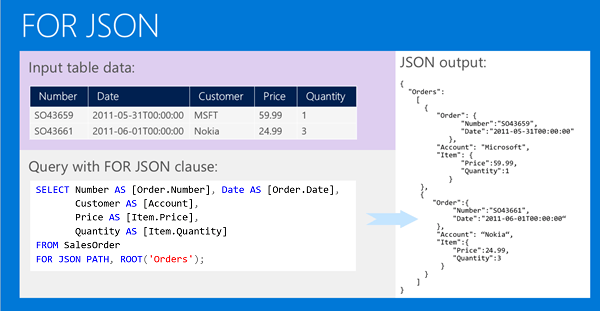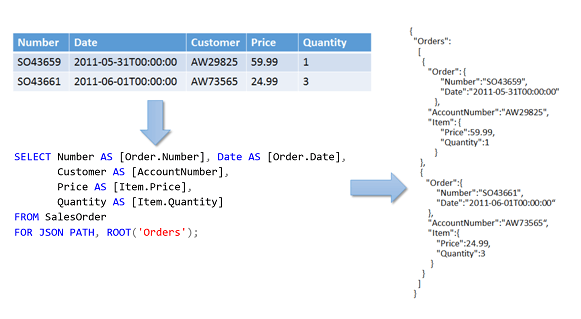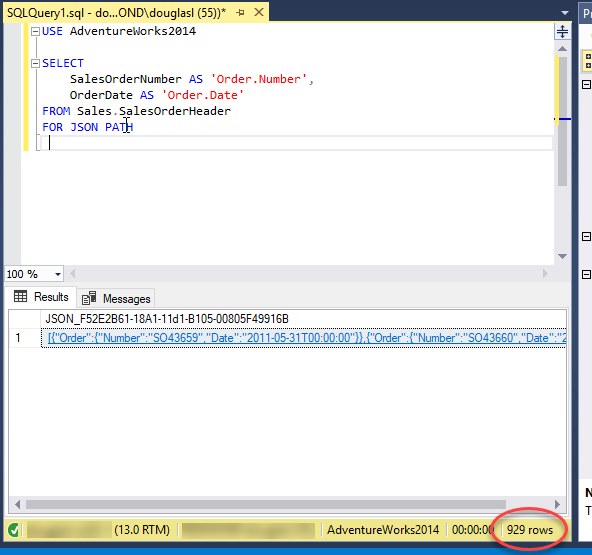Note
Access to this page requires authorization. You can try signing in or changing directories.
Access to this page requires authorization. You can try changing directories.
Applies to:
SQL Server 2016 (13.x) and later versions
Azure SQL Database
Azure SQL Managed Instance
Azure Synapse Analytics (serverless SQL pool only)
SQL analytics endpoint in Microsoft Fabric
Warehouse in Microsoft Fabric
SQL database in Microsoft Fabric Preview
Format query results as JSON, or export data from SQL Server as JSON, by adding the FOR JSON clause to a SELECT statement. Use the FOR JSON clause to simplify client applications by delegating the formatting of JSON output from the app to SQL Server.
Note
Azure Data Studio is the recommended query editor for JSON queries because it auto-formats the JSON results, as shown in this article. SQL Server Management Studio displays an unformatted string.
In Fabric Data Warehouse, FOR JSON must be the last operator in the query, and so is not allowed inside subqueries.
Format query results
When you use the FOR JSON clause, you can specify the structure of the JSON output explicitly, or let the structure of the SELECT statement determine the output.
To maintain full control over the format of the JSON output, use
FOR JSON PATH. You can create wrapper objects and nest complex properties.To format the JSON output automatically based on the structure of the
SELECTstatement, useFOR JSON AUTO.
Here's an example of a SELECT statement with the FOR JSON clause and its output.

Control output with FOR JSON PATH
In PATH mode, you can use the dot syntax - for example, Item.Price - to format nested output.
Here's a sample query that uses PATH mode with the FOR JSON clause. The following example also uses the ROOT option to specify a named root element.

More info about FOR JSON PATH
For more detailed info and examples, see Format Nested JSON Output with PATH Mode.
For syntax and usage, see SELECT - FOR Clause (Transact-SQL).
Control other JSON output options
Control the output of the FOR JSON clause, using the following extra options.
ROOTTo add a single, top-level element to the JSON output, specify the
ROOToption. If you don't specify this option, the JSON output doesn't have a root element. For more info, see Add a Root Node to JSON Output with the ROOT Option.INCLUDE_NULL_VALUESTo include null values in the JSON output, specify the
INCLUDE_NULL_VALUESoption. If you don't specify this option, the output doesn't include JSON properties forNULLvalues in the query results. For more info, see Include Null Values in JSON - INCLUDE_NULL_VALUES Option.WITHOUT_ARRAY_WRAPPERTo remove the square brackets that surround the JSON output of the
FOR JSONclause by default, specify theWITHOUT_ARRAY_WRAPPERoption. Use this option to generate a single JSON object as output from a single-row result. If you don't specify this option, the JSON output is formatted as an array - that is, the output is enclosed within square brackets. For more info, see Remove Square Brackets from JSON - WITHOUT_ARRAY_WRAPPER Option.
Output of the FOR JSON clause
The output of the FOR JSON clause has the following characteristics:
The result set contains a single column.
- A small result set can contain a single row.
- A large result set splits the long JSON string across multiple rows.
By default, SQL Server Management Studio (SSMS) concatenates the results into a single row when the output setting is Results to Grid. The SSMS status bar displays the actual row count.
Other client applications might require code to recombine lengthy results into a single, valid JSON string by concatenating the contents of multiple rows. For an example of this code in a C# application, see Use FOR JSON output in a C# client app.

The results are formatted as an array of JSON objects.
The number of elements in the JSON array is equal to the number of rows in the results of the SELECT statement (before the FOR JSON clause is applied).
Each row in the results of the SELECT statement (before the FOR JSON clause is applied) becomes a separate JSON object in the array.
Each column in the results of the SELECT statement (before the FOR JSON clause is applied) becomes a property of the JSON object.
Both the names of columns and their values are escaped according to JSON syntax. For more info, see How FOR JSON escapes special characters and control characters.
Example
Here's an example that demonstrates how the FOR JSON clause formats the JSON output.
Query results
| A | B | C | D |
|---|---|---|---|
| 10 | 11 | 12 | X |
| 20 | 21 | 22 | Y |
| 30 | 31 | 32 | Z |
JSON output
[{
"A": 10,
"B": 11,
"C": 12,
"D": "X"
}, {
"A": 20,
"B": 21,
"C": 22,
"D": "Y"
}, {
"A": 30,
"B": 31,
"C": 32,
"D": "Z"
}]